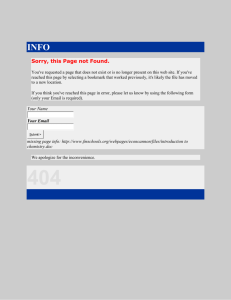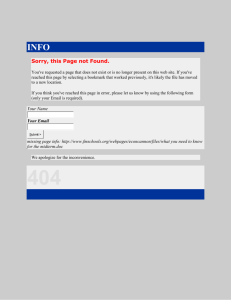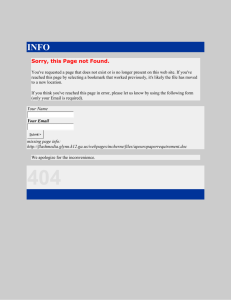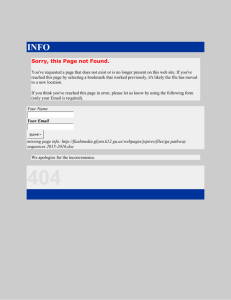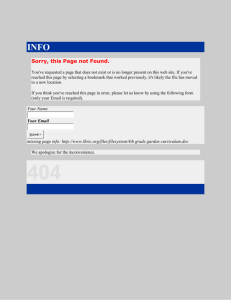Project Charter - Kelly Project Solutions
advertisement
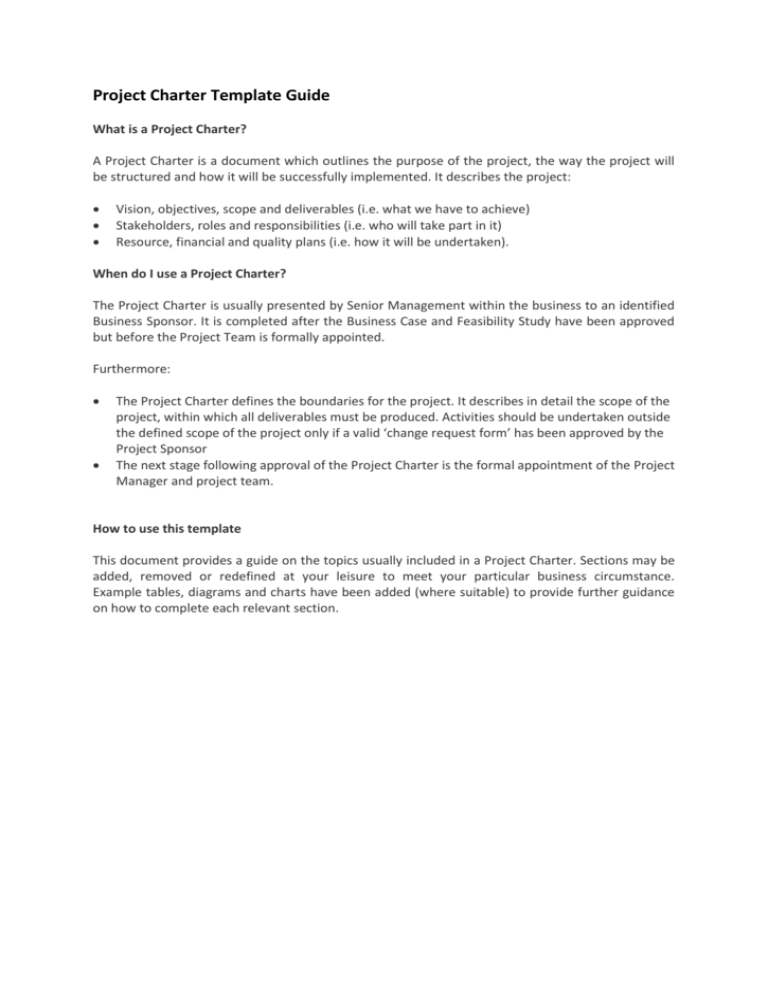
Project Charter Template Guide What is a Project Charter? A Project Charter is a document which outlines the purpose of the project, the way the project will be structured and how it will be successfully implemented. It describes the project: Vision, objectives, scope and deliverables (i.e. what we have to achieve) Stakeholders, roles and responsibilities (i.e. who will take part in it) Resource, financial and quality plans (i.e. how it will be undertaken). © When do I use a Project Charter? The Project Charter is usually presented by Senior Management within the business to an identified Business Sponsor. It is completed after the Business Case and Feasibility Study have been approved but before the Project Team is formally appointed. Furthermore: The Project Charter defines the boundaries for the project. It describes in detail the scope of the project, within which all deliverables must be produced. Activities should be undertaken outside the defined scope of the project only if a valid ‘change request form’ has been approved by the Project Sponsor The next stage following approval of the Project Charter is the formal appointment of the Project Manager and project team. © How to use this template This document provides a guide on the topics usually included in a Project Charter. Sections may be added, removed or redefined at your leisure to meet your particular business circumstance. Example tables, diagrams and charts have been added (where suitable) to provide further guidance on how to complete each relevant section. TEMPLATE GUIDE ........................................................................................................... 1 PROJECT OVERVIEW ................................................................................................. 3 1 1.1 1.2 1.3 1.4 1.5 1.6 1.7 1.8 PROBLEM STATEMENT ........................................................................................................................... 3 PROJECT DESCRIPTION ........................................................................................................................... 3 ORGANIZATIONAL ALIGNMENT ..................................................................... ERROR! BOOKMARK NOT DEFINED. PROJECT GOALS & OBJECTIVES .................................................................................................................. 3 PROJECT SCOPE .................................................................................................................................. 3 CRITICAL SUCCESS FACTORS...................................................................................................................... 3 ASSUMPTIONS .................................................................................................................................... 4 CONSTRAINTS .................................................................................................................................... 4 BUSINESS CASE ....................................................................................................... 4 2 2.1 2.2 2.3 2.4 BENEFITS ......................................................................................................................................... 4 COSTS ............................................................................................................................................ 5 FEASIBILITY ....................................................................................................................................... 5 SWOT ANALYSIS ................................................................................................................................ 5 PROJECT MILESTONES & AUTHORITY ............................................................................... 6 3 3.1 3.2 3.3 PROJECT OVERSIGHT AUTHORITY ................................................................... ERROR! BOOKMARK NOT DEFINED. FUNDING AUTHORITY ............................................................................... ERROR! BOOKMARK NOT DEFINED. MAJOR PROJECT MILESTONES ................................................................................................................... 6 PROJECT ORGANIZATION .................................................... ERROR! BOOKMARK NOT DEFINED. 4 4.1 4.2 4.3 PROJECT STRUCTURE ................................................................................ ERROR! BOOKMARK NOT DEFINED. ROLES & RESPONSIBILITIES ......................................................................... ERROR! BOOKMARK NOT DEFINED. PROJECT FACILITIES & RESOURCES.................................................................. ERROR! BOOKMARK NOT DEFINED. 5 POINTS OF CONTACT ......................................................... ERROR! BOOKMARK NOT DEFINED. 6 GLOSSARY .................................................................... ERROR! BOOKMARK NOT DEFINED. 7 APPENDICES .................................................................. ERROR! BOOKMARK NOT DEFINED. 8 REVISION HISTORY ................................................................................................... 6 1 1.1 Kelly Project Solutions (KPS) Overview Problem Statement The recent economic downturn has brought into focus the need for organizations to: 1. Enhanced project selection/intake 2. Improved Project Execution/Delivery 3. Improved Risk Management With the stimulus plan injecting billions of dollars into the economy and countless reports of inadequate talent pool to match, potential clients are having a difficult time matching resources and project initiatives with their strategy. 1.2 Company Description KPS will be a firm that is focused on project management execution vs. developing Project Management training solutions, PPM software development, or developing proprietary methodologies. 1.3 Company Goals & Objectives The core goals of KPS include: Securing our 1st client by Aug-‘11 Secure 2nd and 3rd client by end of calendar year 2011 Hire PM consultant and shift to managing company and growing firm in Dec-‘11/Jan-‘12 1.4 Company Scope/Services Describe the project scope. The scope defines project limits and identifies the products and/or services delivered by the project. The scope establishes the boundaries of the project and should describe products and/or services that are outside of the project scope. Services Included Project Management Resources – PMs interviewing & screening PMs, not 15 min’s phone screens from general recruiters PMO Development – Analysis of ‘as-is’, recommendation for PMO, develop plan, implement, and organizational awareness/support/training Hosted PMO – Develop a PMO and host templates, on-going project documentation, PPM tool/s Project Consulting – Initiation and Requirements Gathering, Project Plan Review/Validation of incumbent, project rescue Services Excluded PMP/PMI Training – We will not be training PMs to become PMPs Software Development – We will not create new PPM software tools. Proprietary Methodologies – i.e. TenStep or Method 1-2-3 1.5 Critical Success Factors Describe the factors or characteristics that are deemed critical to the success of a project, such that, in their absence the project will fail. 1.6 Assumptions Describe any project assumptions related to business, technology, resources, scope, expectations, or schedules 1.7 Constraints Describe any project constraints being imposed in areas such as schedule, budget, resources, products to be reused, technology to be employed, products to be acquired, and interfaces to other products. List the project constraints based on the current knowledge today. 2 Business Case This section provides a full listing of all solution options, their benefits, costs, feasibility, risks and issues. Options suggested may include doing nothing, doing something that will achieve a similar result or doing something that will achieve a better result than current performance. Try to minimize the number of options available by conducting a detailed Feasibility Study beforehand. For each solution option identified, the following information is required: 2.1 Benefits Describe the tangible and intangible benefits to the company upon implementation of the solution. One of the obvious benefits described will be that the business problem / opportunity outlined above will be addressed. Complete the following table: Category Financial Benefit New revenue generated Reduction in costs Increased profit margin Value© $x $x $x Operational Improved operational efficiency Reduction in product time to market Enhanced quality of product / service x% x hrs x% Market Increased market awareness Greater market share Additional competitive advantage x% x% Describe Customer Improved customer satisfaction Increased customer retention Greater customer loyalty x% x% Describe Staff Increased staff satisfaction Improved organizational culture Longer staff retention x% Describe x% 2.2 Costs Describe the tangible and intangible costs to the company upon implementation of the solution. The costs of the actual project should be included (e.g. equipment procured) as well as any negative impact to the business resulting from the delivery of the project (e.g. operational down-time). Complete the following table: Category People Cost Salaries of project staff Contractors / outsourced parties Training courses Value $x $x $x Budgeted YES NO YES Physical© Building premises for project team Equipment and materials Tools (computers, phones…) $x $x $x NO NO NO Marketing Advertising / branding Promotional materials PR and communications $x $x $x YES NO NO Organizational Operational down-time Short-term loss in productivity Cultural change $x $x Describe NO NO NO 2.3 Feasibility Describe the feasibility of the solution. To adequately complete this section, a Feasibility Study may need to be initiated to quantify the likelihood of achieving the desired project result. To assess the overall feasibility of this option, break the solution down into components and rate the feasibility of each component in the following table: Component New Technology New People © New Processes New Assets 2.4 Rating (1-10) 5 8 3 9 Method Used to Determine Feasibility A technology Prototype was created to assess the solution A survey was completed to identify skill-set availability Processes within similar organizations were reviewed Physical assets were inspected SWOT Analysis Strengths – Experience, Geography, Innovation, Qualifications, Price, Value, Quality, etc Weaknesses – Deadline, Systems, Capital, Reliability of Data, etc Opportunity – Competitor Vulnerability, Industry Shift, Niche Market, etc Threats – Legislative, Market Demand, Loss of Key Staff, etc S W O 3 T KPS Start-Up Milestones 3.1 Major Project Milestones Milestone/Deliverable Target Date Must Have? Y/N Y/N Y/N Y/N 4 Project Organization Insert project org chart, project ‘war rooms’, roles and responsibilities of key team members 5 Points of Contact Name – Position – Department – Phone Number - Email 6 Glossary Insert common acronyms and terms 7 Appendices Insert any schemas, diagrams, tech specs, etc 8 Revision History Version Date Name Description
